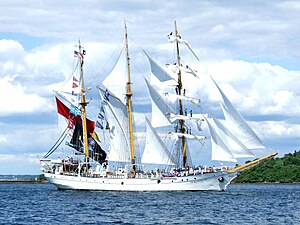
A schooner is a type of sailing vessel defined by its rig: fore-and-aft rigged on all of two or more masts and, in the case of a two-masted schooner, the foremast generally being shorter than the mainmast. A common variant, the topsail schooner also has a square topsail on the foremast, to which may be added a topgallant. Differing definitions leave uncertain whether the addition of a fore course would make such a vessel a brigantine. Many schooners are gaff-rigged, but other examples include Bermuda rig and the staysail schooner.

A sailing vessel's rig is its arrangement of masts, sails and rigging. Examples include a schooner rig, cutter rig, junk rig, etc. A rig may be broadly categorized as "fore-and-aft", "square", or a combination of both. Within the fore-and-aft category there is a variety of triangular and quadrilateral sail shapes. Spars or battens may be used to help shape a given kind of sail. Each rig may be described with a sail plan—formally, a drawing of a vessel, viewed from the side.

A brig is a type of sailing vessel defined by its rig: two masts which are both square-rigged. Brigs originated in the second half of the 18th century and were a common type of smaller merchant vessel or warship from then until the latter part of the 19th century. In commercial use, they were gradually replaced by fore-and-aft rigged vessels such as schooners, as owners sought to reduce crew costs by having rigs that could be handled by fewer men. In Royal Navy use, brigs were retained for training use when the battle fleets consisted almost entirely of iron-hulled steamships.
A jib is a triangular sail that sets ahead of the foremast of a sailing vessel. Its tack is fixed to the bowsprit, to the bows, or to the deck between the bowsprit and the foremost mast. Jibs and spinnakers are the two main types of headsails on a modern boat.
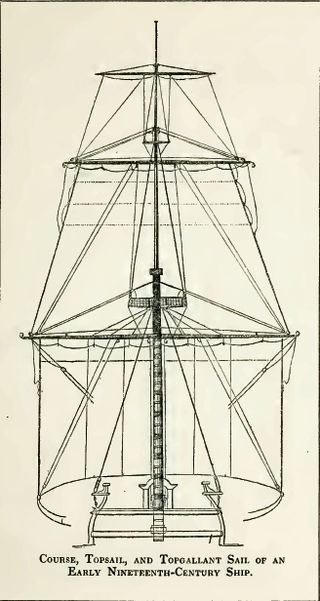
A topsail ("tops'l") is a sail set above another sail; on square-rigged vessels further sails may be set above topsails.

A staysail ("stays'l") is a fore-and-aft rigged sail whose luff can be affixed to a stay running forward from a mast to the deck, the bowsprit, or to another mast.

A cutter is a name for various types of watercraft. It can apply to the rig of a sailing vessel, to a governmental enforcement agency vessel, to a type of ship's boat which can be used under sail or oars, or, historically, to a type of fast-sailing vessel introduced in the 18th century, some of which were used as small warships.

A barquentine or schooner barque is a sailing vessel with three or more masts; with a square rigged foremast and fore-and-aft rigged main, mizzen and any other masts.

A lugger is a sailing vessel defined by its rig, using the lug sail on all of its one or more masts. Luggers were widely used as working craft, particularly off the coasts of France, England, Ireland and Scotland. Luggers varied extensively in size and design. Many were undecked, open boats, some of which operated from beach landings. Others were fully decked craft. Some larger examples might carry lug topsails.
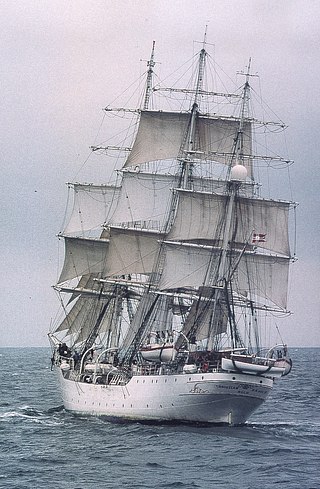
A full-rigged ship or fully rigged ship is a sailing vessel with a sail plan of three or more masts, all of them square-rigged. Such a vessel is said to have a ship rig or be ship-rigged, with each mast stepped in three segments: lower, top, and topgallant.

A Thames sailing barge is a type of commercial sailing boat once common on the River Thames in London. The flat-bottomed barges, with a shallow draught and leeboards, were perfectly adapted to the Thames Estuary, with its shallow waters and narrow tributary rivers. The larger barges were seaworthy vessels, and were the largest sailing vessel to be handled by just two men. The average size was about 120 tons and they carried 4,200 square feet (390 m2) of canvas sail in six working sails. The mainsail was loose-footed and set up with a sprit, and was brailed to the mast when not needed. It is sheeted to a horse, as is the foresail; they require no attention when tacking. The foresail is often held back by the mate to help the vessel come about more swiftly.

Earl of Pembroke was a wooden, three-masted barque, which was frequently used for maritime festivals, charters, charity fund raising, corporate entertaining and film work.
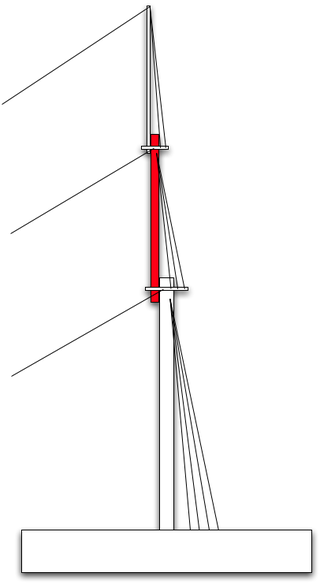
The masts of traditional sailing ships were not single spars, but were constructed of separate sections or masts, each with its own rigging. The topmast is one of these.

Preussen (PROY-sin) was a German steel-hulled, five-masted, ship-rigged sailing ship built in 1902 for the F. Laeisz shipping company and named after the German state and kingdom of Prussia. She was the world's only ship of this class with five masts, carrying six square sails on each mast.

Potosi was a five-masted steel barque built in 1865 by Joh. C. Tecklenborg ship yard in Geestemünde, Germany, for the sailing ship company F. Laeisz as a trading vessel. Its primary purpose was as a "nitrate clipper" collecting guano in South America for use in chemical companies in Germany. As its shipping route was between Germany, Bolivia until 1870 but, during the "pacific War" was transferred to Chile, it was designed to be capable of withstanding the rough weather encountered around Cape Horn.
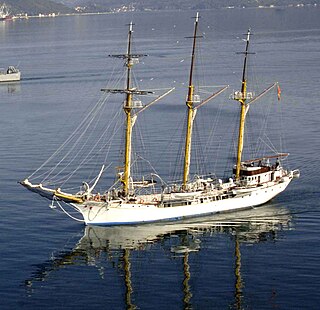
Jadran is a sailing ship for basic naval training built for the Yugoslav Royal Navy and currently in Montenegrin Navy service. A three-mast topsail schooner or barquentine with an auxiliary engine, Jadran was built in Hamburg, Germany between 1930 and 1933, and commissioned on 19 August 1933. Prior to World War II she completed seven long training cruises with trainees from the Yugoslav Naval Academy, including one to North America. As Yugoslavia was neutral at the outbreak of World War II, Jadran was able to conduct short cruises in the Adriatic Sea. In April 1941, Yugoslavia was invaded by the Axis powers, and Jadran was captured and renamed Marco Polo by the Italian Navy. She continued to be used as a training ship in the Adriatic, operating out of the Istrian port of Pola, and was featured in an Italian propaganda film.
Alexandria was a cargo-carrying three-masted schooner built in 1929. Originally named Yngve, she was built at Björkenäs, Sweden, and fitted with a 58 H.P. auxiliary oil engine.

The tall ship Spirit of New Zealand is a steel-hulled, three-masted barquentine from Auckland, New Zealand. It was purpose-built by the Spirit of Adventure Trust in 1986 for youth development. It is 42.5 m in total length and carries a maximum of 40 trainees and 14 crew on overnight voyages. The ship's home port is Auckland, and it spends most of its time sailing around the Hauraki Gulf. During the summer season, it often sails to the Marlborough Sounds and Nelson, at the top of the South Island.

HMS Thistle was a Bramble-class gunboat of the Royal Navy, launched in 1899 and broken up in 1926. She was the last classic Victorian gunboat, and the last British warship to retain a practical sailing rig.

A sail plan is a drawing of a sailing craft, viewed from the side, depicting its sails, the spars that carry them and some of the rigging that supports the rig. By extension, "sail plan" describes the arrangement of sails on a craft. A sailing craft may be waterborne, an iceboat, or a sail-powered land vehicle.
